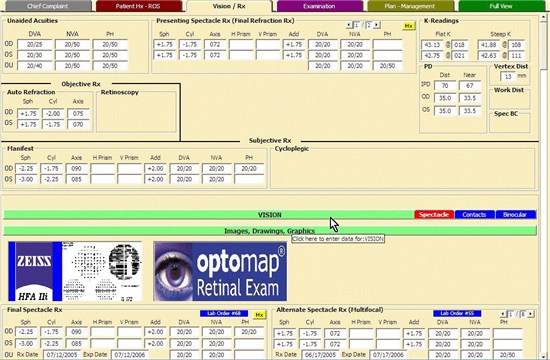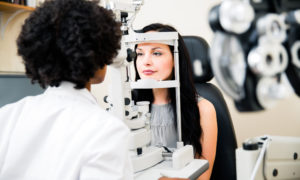Palmer N. Lee, OD

Electronic health records can improve interaction between doctor and patient in the exam room. Utilize this technology for more meaningful discussions of eye health and lifestyle needs.
When facing your patient in the exam room, it can be easy to overlook important eye health and lifestyle issues that should be discussed. It helps if you have a record at your fingertips prompting you to talk about these things with each patient. That’s what electronic records do in the exam room for me–theyprovidean easy-to-access file of data on patients including past eye health, vision complaints, diagnoses and past purchases–that I can use to start in-depth conversations. Here is how my practice uses our electronic records, ExamWRITER, with our practice management system, OfficeMate, to facilitate enhanced interaction between doctor and patient in the exam room.
 A typical screen inside the ExamWRITER EHR program that Dr. Palmer uses.
A typical screen inside the ExamWRITER EHR program that Dr. Palmer uses.
Have Staff Support Data Load Prior to Patient Visits
Prior to each routine comprehensive examination, my support staff inputs all medical information, the chief complaint, reason for the visit, acuities, IOP, keratometry and retinal photography. If it is a medical visit, my staff will also enter all medical history, chief complaint, and do any pre-testing that might be pertinent to that visit. Before entering the examination room I review the chart for that day’s visit and and previous visits.
Upon entering the examination room, I want to be familiar with the patient and their chief complaint, so our electronic records allows me to greet the patient with familiarity and confidence, as I know why they are here. Editors note: The ROS and the PFS histories can be taken by ancillary staff, however, the physician must take the HPI.
Build Templates to Review Information as Desired on EHR
ExamWRITER enables you to view the entire examination record on one screen. In addition, we built custom templates that allow us easy access to the information we deem most important in the records.
Review Information Before Patient Enters Exam Room
I review chief complaint, HPI, medical history, family history, occupation, medications, surgical history, ocular family history, therapeutic side effects, review of systems, presenting Rx, acuity and retinal photography. By reviewing this information I become quite familiar with the patient prior to entering the examination room. I think this is paramount. I personally find nothing more frustrating than seeing a doctor who walks in and says: “…and why are you here today?” Patients begin to wonder if anyone reads their charts. If they are a prior patient, they may wonder why nobody on staff seems to remember them.
Review Information with Patient
After the initial greeting and small talk, my first question is about the patient’s chief complaint. The computer monitor featuring the patient’s health history and past instrumentation photos is a visual to both the patient and myself giving the patient and I the opportunity to review the information together. Sometimes a patient may not remember when they were last in our office or how long they have had their sunglasses. If they got prescription sunwear three years ago, they might think it was last year. With all of their information readily accessible, it is very easy to review together.
Having the retinal scan for this year and previous years on the screen is priceless. The patient and I will review these together. This gives me a great opportunity to educate the patient about their eye health. In so many areas, such as IOP, this is important. With the patient I can look at this year’s reading and quickly pull previous years’ to see if there has been any change or increase in intraocular pressure.
Review Lifestyle-Related Prescriptions
I have the patient’s occupation, hobbies and other lifestyle details right in front of me, which helps me understand their needs. I can also review previous year’s information as to what they purchased. An example might be a 50-year-old patient who purchased single-vision distance sunglasses three years ago. I can easily see the information and ask questions as to how they read with their sunwear. This allows me to make appropriate recommendations and design an appropriate new sunglass for both distance and near.
Doctor Inputs All Exam Room Information; Maintain Eye Contact with Patient
All examination information is entered in the exam room by the doctor. I make a conscious effort to look directly at the patient while I am addressing them. If I input information I will excuse myself, tell them I am going to enter some information, do it quickly and then turn back to face them. I enter a significant part of the information after the patient has left the room. I will call for an optician and hand them off. After I reviewed with the optician and the patient what I recommend, I will let them know when I want to see them next, say goodbye, and also say: “it was great seeing you again. I am going to let you and (optician’s name), move into the frame gallery while I spend a few minutes here inputting the rest of your examination information.”
Use EHR to Aid Hand-Off to Optical Team
I bring the optician into the exam room and do the hand-off by discussing the visual needs of the patient…drawing both the optician and the patient into that conversation. After they leave the examination room, I input my recommendations, and the optician then will pull the examination record up in the dispensary and review my recommendations a second time.
Three Key Advantages of EHR for Doctor-Patient Interaction
Easy access to patient records, current and previous. I am able to not only review eye health and general medical history easily before each exam, but I also can see at the click of the mouse the patient’s demographic information and past purchases. This allows me to provide better targeted prescriptions for eyewear.
We have three offices and I can pull up any information I might need from one of the other locations. Prior to electronic records, if a patient came in from one of our other offices, we would have to call over and have the information faxed. This is cumbersome and time-consuming.
Having the records visual to the patient allows them to participate by observing the information that has been inputted. Patient education is facilitated by being able to show pictures from instrumentation and I can show them the progress of their treatment and what further treatment is needed.
Related ROB Articles
Ease Your Transition to EHR with Comprehensive Training
Guide to Meeting HIPAA Requirements When Using Your EHR
EHR Protocol: Set Up Consistent Rules to Maximize Benefits
Palmer N. Lee, OD, is the owner of EYEcenter Optometric in Citrus Heights, Calif. To contact: drpalmerlee@gmail.com



























